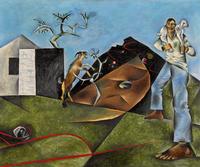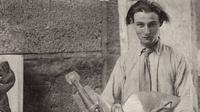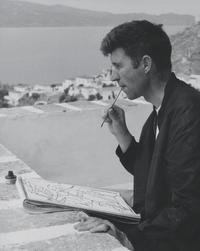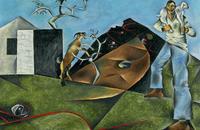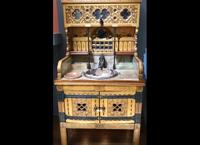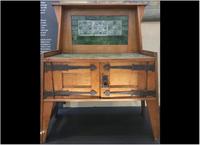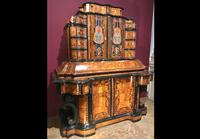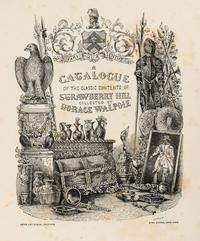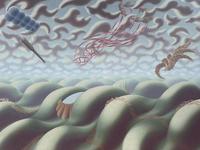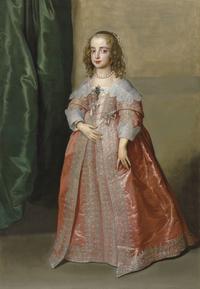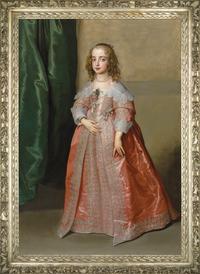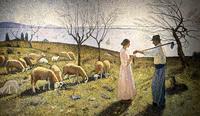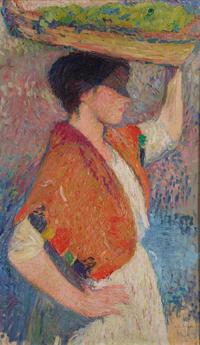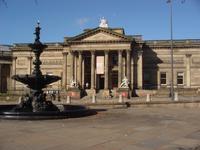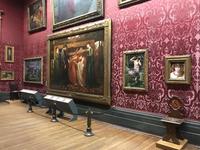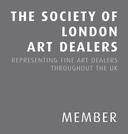Image Index

This subject matter is typical of Ansdell who injected his hunting and sporting scenes with a subtle melodrama, telling the story of the hunt in a single image. A Good Day’s Sport seems to tell of a fruitful but exhausting hunt, picturing a moment of respite after the action. Ansdell was a great lover of Scotland and each of his pictures seem an ode to the country, glorifying its traditions and landscape.
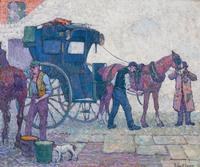
The Hansom Cab is a particularly refined example of Bevan’s urban horse paintings. Owned by family friends of Bevan since first purchase, and not seen in public for nearly seventy years, it demonstrates Bevan’s first-hand knowledge of the French avant-garde through his close contact with the Pont-Aven School in Brittany. Bevan had been allowed to give up the family banking business to study art in London and Paris and he spent time in Pont-Aven in the early 1890s.

King Cophetua and the Beggar Maid is a smaller, experimental version of the oil painting that hangs in Tate Britain (1884) and the bodycolour, watercolour and pastel cartoon of the same subject in Birmingham Museums and Art Gallery (1883). A gouache and gum arabic picture (1883) of the same subject is in The Lord Lloyd-Webber Collection. According to a sixteenth century folk ballad, King Cophetua was an African King who, previously immune to female beauty, fell in love at first sight with a beggar maid.

Sir George Clausen was an English artist of great longevity who held a position of huge importance in British art at the turn of the century. His art merges the worlds of natural realism and British Impressionism and provides a survey of predominantly rural pre- and post-World War I life in England. Over the course of his career, he developed a more fluid style, portraying movement and the play of sunlight and shade with flickering brushstrokes.
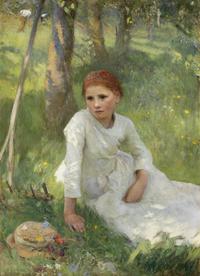
In this beautiful painting of one of Clausen’s favourite models, Rose Grimsdale, rest, reverie and the sunlit glow of field and wildflowers combine to produce one of the most satisfying visions of the English countryside at the end of the nineteenth century. Clausen’s work contains sentiment but it is not sentimental. His art always conveyed a poetical appreciation of the natural world akin to the literary works of Thomas Hardy. Clausen’s observations of rural life were accurate but by the late nineties it had become clear that he and his French and British contemporaries were not so much recording the occupation of the country labourer as bolstering a threatened way of life.

Deverell’s Twelfth Night, painted when he was twenty-one, is undoubtedly his masterpiece. It is by far the largest of his few surviving paintings and was clearly intended to be a major statement and a bid for recognition. Everything about it betrays Deverell’s allegiance to the Pre-Raphaelite Brotherhood of which he remained one of their closest associates during the period. Deverell’s Twelfth Night is one of the last major early Pre-Raphaelite paintings to remain in private hands.
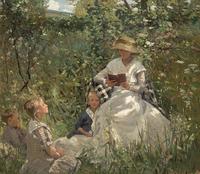
Hilda Fearon was an important female member of the British Impressionist movement. Born in Banstead, Surrey in 1878, to a wealthy London wine merchant, she was the younger sister of the painter Annie (Fearon) Walke. Fearon studied with her sister at the Chelsea Art School and at the Slade School and shortly thereafter they moved to Dresden together to study under Robert Sterl. They both then moved to Cornwall, where Fearon gained her most significant training with Algernon Talmage in St Ives from 1900, where many female painters of her day were drawn to paint.
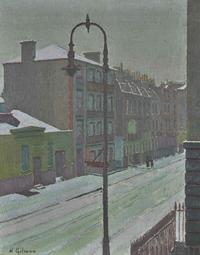
Gilman understood that the truly modern subject was the city, its back rooms and bed-sits and the quiet dignity of the isolated people who inhabited them. The perceived dislocation of his art may be seen in the painterly A London Street Scene in Snow which is almost completely disassociated from the urban sprawl and bustle. Always happiest with the static image, his cityscapes avoid the continual movement of the urban world.
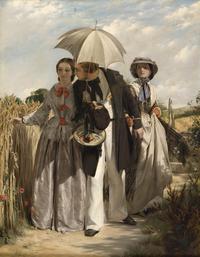
Mr Horsley’s naval lieutenant (H.M.S. Trifler) is “showing a preference” in a very indiscreet and decided manner. The very poppies hang their heads in shame.’ Punch (responding to the 1860 Royal Academy exhibit) In this work and others of his oeuvre, Horsley successfully depicts tight psychological narratives, incorporating figures who outwardly show a quiet, almost inscrutable, self-possession but whose internal thoughts are hinted at. Here, Horsley chooses a subject that serves as a metaphor for the shallowness of male romantic feelings, as the officer jilts one woman in preference for another.
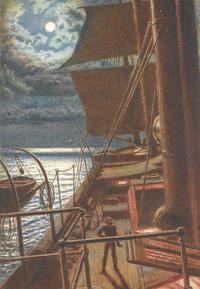
‘The moon makes for herself a clear path through clouds which crown, or rather encircle, her head with a halo of iridescent light. The sea beneath shines as burnished silver.’ The Art Journal Homeward Bound was painted in 1869 and sent to England in the autumn of the following year to be exhibited at the Old Watercolour Society, as the artist’s letter of 12 October to A.W. Hunt reveals: ‘I have lately sent home a couple of water colour drawings and I wish to give them to be mounted and framed to a safe man….
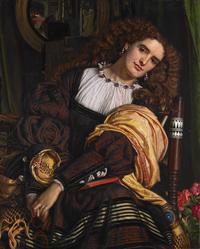
Begun in 1859, put aside and taken up again in 1865, and finally exhibited at the Royal Academy in 1867, this picture marked a radical departure for Hunt, as the title alone - with its Italian colloquial implication of ‘sweet idleness’ or ‘indolence’ indicates. No member of the Pre-Raphaelite Brotherhood had been more single-minded than Hunt in his determination to paint serious subjects replete with meaning and moral significance. His early works, if they had not been based on the Bible or Shakespeare, had at least had this ethical dimension, and in 1854 he had taken this approach to its logical conclusion by going to the Holy Land to paint biblical events on the very spot where they had occurred.

This elegant portrait of a young woman, shown sitting in an idyllic, pastoral landscape, was painted by German painter Frederick Kerseboom. It is a prime example of the late-Baroque style, which blends realistic depictions with symbols of wealth and prestige. The sitter’s serene countenance is uncommon in the portraits of Sir Godfrey Kneller and other contemporaries of Kerseboom. The subject’s identity is unknown. She is shown sitting in a naturalistic setting that shows a far-off view of a lake surrounded by trees, and she is dressed in lavish draperies with classical influences.
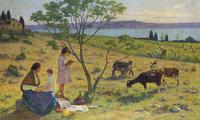
A native of Toulouse, Henri Martin’s roots in the South of France gave him an innate love of sun-drenched landscapes and a profound sense of man’s need to coexist harmoniously with nature. His paintings evoke the southern sun and have an other-worldly, dream-like atmosphere, often celebrating mankind embroiled in and at one with his surroundings. Martin studied at the Ecole des Beaux-Arts and received a grant enabling him to go to Paris to continue his studies.
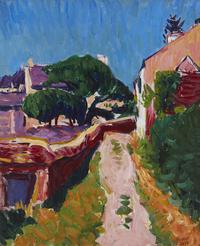
‘I like Brittany; here I find a savage, primitive quality. When my clogs echo on this granite ground, I hear the dull, muted, powerful sound I am looking for in painting.’ Paul Gauguin In 1895 O’Conor left the town of Pont-Aven in Finistère and moved his base further inland to the picturesque village and artists’ colony of Rochefort-en-terre in the Morbihan district of Brittany. Pont-Aven had become overrun with artists and tourists by this date, and O’Conor would have been charmed by the unspoilt character and colourful history of Rochefort with its twelfth-century church and fourteenth-century ruined castle.
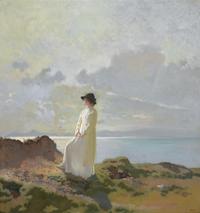
From 1909 onwards, William Orpen spent the month of August with his wife, Grace and their two children, at Howth Head overlooking Dublin Bay in a house known as ‘The Cliffs’. The headland afforded panoramic views of the Irish Sea to the east and Bray Head, the Wicklow Hills and ‘Sugarloaf’ mountain to the south. Despite Howth’s popularity with earlier artists such as Nathaniel Hone and Walter Osborne, it remained relatively unexplored, and it was here, on its rugged crown, that Orpen was inspired to paint a number of his most important canvases.
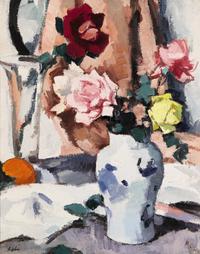
Through his still life painting, Samuel John Peploe experimented with the manipulation of colour and form. Working in his sun-drenched studio, the artist surrounded himself with potential subjects. As described by Elizabeth Cumming: ‘Flowers in season, roses following on from tulips, partner ceramic bowls or vases, set against a length of beautiful fabric (sometimes purchased from the Edinburgh furnishers Whytock & Reid), all so carefully selected, arranged and rearranged time and again before brush was ever put to canvas.
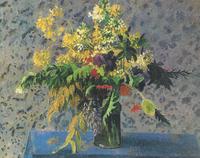
With Pissarro’s painting Bouquet de Fleurs; Iris, Coquelicots et Fleurs de Choux, we see an artist – a master - completely at ease in his style. There is a completeness of design and technique, with a harmony and synthesis of colour and texture; tones are perfectly balanced within a perfectly balanced structure of composition. The brushwork, although bold, has a delicacy of control and execution which gives a calm and tranquil air to the exuberance of the colourisation – the technique appears simple belying the complexity of the artist’s handling.
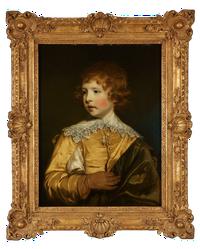
Exhibited Worcestershire Exhibition 1882; Grosvenor Gallery 1883 (202); Guildhall 1890 (191); 45 Park Lane 1937 (50); Royal Academy 1986 (76). Literature Graves, A., and Cronin, W.V., History of the Works of Sir Joshua Reynolds, vol. 1, London, 1899-1901, pp. 191-2; Waterhouse, E.K., Reynolds, London, 1941, p.61; Cormack, M., The Ledgers of Sir Joshua Reynolds, Walpole Society, XLII, 1970, p. 116; Penny, N. et al., Reynolds, London, 1985, p. 120 (illustrated), pp.
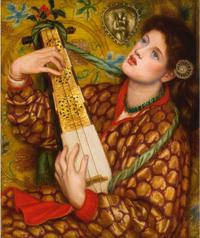
A Christmas Carol is one of Rossetti’s earliest of a series of half-length depictions of women playing musical instruments. The connection with female beauty, music and the fashion for exotic decoration and costume were central themes of the emerging English Aesthetic movement – the revolutionary artistic style of the 1860s and 1870s that combined elements of Renaissance, Oriental and Classical styles to create an époque that was to be as important in Britain as Art Nouveau was in Europe.
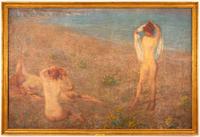
What a blaze of sunshine! Three women bask in the bright sun… Parallels cannot fail to be established between the Baigneuses of Steer and the Poseuses of Seurat…’ Then Steer invited me to go to his house – I went there this morning. He divides the tones in our way and is very intelligent, he is an artist after all! In 1891 Philip Wilson Steer read a brief paper on the genealogy of Impressionism at an Art Workers’ Guild soirée.
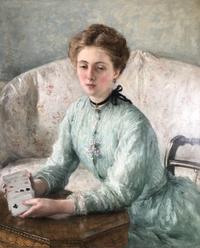
In the late 1880s and by the beginning of the 1890s, Steer was the leading exponent and most progressive of English artists who were taking their inspiration from their French impressionist counterparts. His series of sun-drenched scenes with their close analyses of tone and shadow, evaporating forms and sparkling, broken touches of colour came closer to French Impressionism than anything. He was the most radical artist in Britain, unorthodox and exceptional, employing a distinctive autographic quality of painting and working in a number of different styles simultaneously whilst always maintaining an interest in the relationship between sensation and expression and often creating a visionary intensity.

In Chatterboxes Steer utilised the same techniques employed by the French impressionists. He separated colour and even experimented with the radical effects of the neo-impressionists, believing that light would emanate from tiny touches of pure colour, fractured into small directional strokes that convey the sense of quietly rustling surfaces. He depicts the flickering sunshine in a French landscape and there is a sense of carefree, relaxation and joie de vivre in this evocative canvas showing the glowing faces of gossiping girls who are dressed in the same two-tone blue cotton that was in common use for ouvrière garments and school clothes throughout northern France.
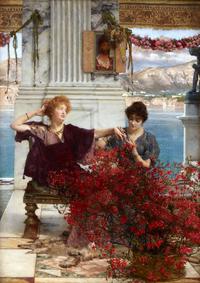
‘for the first-time classical genre subjects were represented with verisimilitude, learning and technical mastery.’ F. G. Stephens, ‘Alma-Tadema’, Artists at Home III This painting is typical of many of Alma-Tadema’s works from the latter part of his career. From the 1880s onwards his paintings were generally small-scale domestic scenes, illustrating either a minor incident or a moment of repose and contemplation. They are ambitious reconstructions of Rome frequently depicting its wealthy citizens at leisure.

Exhibited Yale, 1999; American Federation of Arts: James Tissot: Victorian Life/Modern Love, September 22, 1999-2 July 2000, Exhibition no. 43; Ashmolean, Oxford, 2017, where on loan with The Bunch of Lilacs (1875) and Algernon Moses Marsden (1877); Literature James Tissot’s sales notebook or Carnet de ventes (whereabouts unknown; photocopy in Mantion Collection), second entry under 1876; James Tissot’s photograph album, London. From 1871 to 1878 (private collection), unnumbered, 38th of 64 images, Connoisseur, March 1955, Hammer Galleries advertisement;
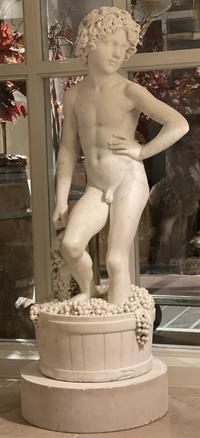
The sculpture depicts a young Bacchus, the mythological Greek god of wine, sculpted out of a luminous white marble and standing in a wine barrel amongst grapes and vines. Bartolini has cleverly utilised the classical contrapposto pose, characterised by a single weight-bearing leg, a bent knee and tilted hips, as a mode to complement Bacchus’ mythology; in this sculpture, he is depicted to be making wine in the traditional manner by stamping on the grapes with bare feet so to release their juice ready for fermentation.
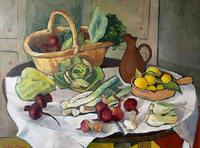
Still Life with Fruit depicts a table still life scene (presumably) in a kitchen. A crisp white table cloth is laid unequally over a dark oval shaped wooden table which is complete with an assortment of vegetables and fruit, such as lettuces, onions, leeks and fennels in the forefront of the painting, and a woven basket and ceramic water-jug in the mid to background. The painting itself is characterised by bold, earthy and warm tones, such as ochres, reds, blues, greens and browns, in addition to brighter and more vibrant colours, such as yellows and reds.
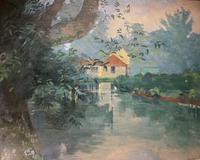
The Fishing Hut, Eddington Fishery is a relatively modern work, although the subject, palette and style bring together the traditions of the Barbizon School and Post-Impressionism. This charming and peaceful scene, executed locally at Eddington stages the beautiful nearby countryside with a sense of untouched timelessness and solitude. Robert (Bob) Brown is an honorary life member of the New English Art Club. His artistic career started early; he studied under Lionel Bulmer and Fred Dubery at Croydon College of Art and at the age of seventeen, he exhibited his first painting at the Royal Academy.
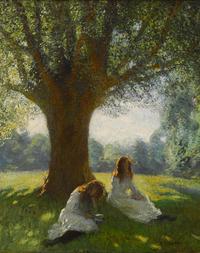
The Spreading Tree was one of the four paintings Clausen exhibited at the Royal Academy in 1901. It was painted when the artist and his family were living in Widdington, near Newport in Essex, an area surrounded by large oaks, which were often painted by the artist and featured in his lectures at the Royal Academy. George Clausen’s four pictures at the Royal Academy in 1901 demonstrated the range and depth of his rural subject matter.

By the turn of the century Clausen’s Impressionist handling was instantly recognised by critics. His palette was rich and varied; he saw colour in shadows and was fully aware of the visual excitement of complementary colour contrasts. In the depiction of landscape he often adopted an aerial viewpoint locating foreground figures on a plane which takes the spectator confidently from the foreground, through the middle distance to the background. In these works a windswept sky with scudding clouds occupies the upper third of the canvas.

‘Make portraits of people in typical, familiar poses’ (An excerpt from Degas' notebooks in the late 1860s, quoted in Exh. cat., Degas Portraits, Zurich, 1994, p. 90). Dating from circa 1864, the present work was painted just a few years before Degas turned towards the ballet as his primary inspiration; however, the portraits of his early oeuvre are some of his most intense and personal, and found him his initial success as an artist.

Edgar Degas is, of course, famous as one of the founders of the Impressionist movement. He was heavily influenced by the realism of artists such as Courbet and Corot and was instrumental in the avant garde Impressionist exhibitions. He is renowned for his later pastel and oil pictures of dancers, racehorse and interior scenes, in which he displays his superb draughtsmanship and the vivid colouristic techniques of the Impressionists. Following his rigorous academic training, in 1856, Degas travelled to Italy where he stayed for three years, copying works by Michelangelo, Raphael, Titian and other Renaissance artists.
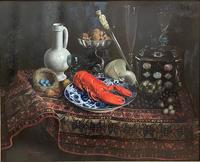
A DISH OF FIGS, Signed, Oil on board, 61 x 50.8cm., 24 x 20in. CRYSTAL SPLENDOUR, Signed and dated 2010, Oil on board, 61 x 50.8cm., 24 x 20in. THE BLUE VASE, Signed and dated 1997, Oil on board, 35.6 x 27.9cm., 14 x 11in. STILL LIFE WITH LOBSTER, Dated 1993, Oil on panel, 74.9 x 91.4cm., 29½ x 36in. From 1963, Willem Leo Jan Dolphyn created around 2,500 paintings. His collection of antique items, including furniture, fabrics, glassware and ceramics filled the rooms of his studio.
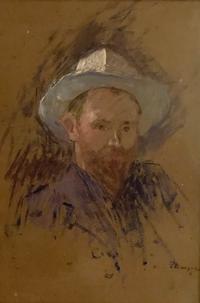
In this self-portrait, Lebasque treats an oil sketch like pastel, employing dry, broad, quick brushstrokes, giving a chalky finish. It is reminiscent of Degas’ pastels in the visible singular colours that create shade and light. A bright sunlight is evident in the cool white on the hat and the white highlight on the face and sheen on the nose, contrasted with the deep shadow of the rest of the face beneath the hat.
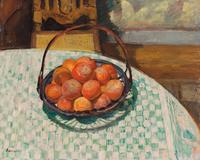
“Intimism, a term which best describes Lebasque’s painting, refers to the close domestic subject matter, supremely realized by Bonnard and Vuillard, in such a manner as to convey the personal nature of his response to the thing painted, and the universal familiarity of home and family. There is a sense of calm infused in Lebasque’s paintings which celebrates the fullness and richness of life. In his placid scenes of gardens and beaches, terraces and dinner tables, Lebasque portrays his family in particular, but in such a way that he appeals to a larger sense of family gathering and devotion” (L.
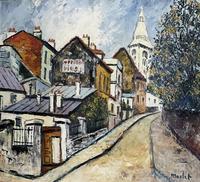
Jules Émile Élisée Maclet (12 April 1881 – 23 August 1962) was a French Impressionist painter, particularly well known for his views of Montmartre. He was born in Lihons-en-Santerre, Picardy, and was the son of a gardener and a laundress. He began his artistic career as something of a weekend painter; Maclet became a choirboy for the local parish church and Father Delval, the parish priest (also an amateur painter), would take the young Maclet out to sketch and paint in the countryside.
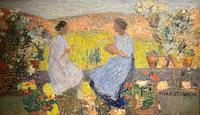
Painstakingly composed of small touches of brilliant colours La Conversation illustrates Henri Martin’s mastery of Neo-Impressionist technique. Depicting an outdoor scene, the picture captures the vibrant effect of sunlight and subtle variations of perfectly harmonised tones. Decomposing the spectrum of light into small brushstrokes of pure colour, La Conversation shows Martin’s ability as a storyteller, colourist, as well as a Neo-Impressionist painter. Two women are in deep conversation in the foreground, whilst at the same time the artist suggests that they may also be sewing or knitting.

At this time in his career, Martin was greatly influenced by the post impressionists. Light had filled his canvas following a scholarship from the Salon to study in Italy and he had moved away from historical and biblical subjects painted in a precise academic tradition to light-filled, dream-like, often symbolist, tranquil canvases painted en plein air, merging an impressionist and pointillist technique with idyllic interpretations of the landscape. He largely abandoned allegory for depictions of joyful nature shrouded in a hazy glow.
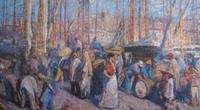
Henri Martin was born in Toulouse in 1860. He studied at the Ecole des Beaux-Arts and received a grant enabling him to go to Paris to continue his studies. In 1885 he travelled to Italy where he observed the Italian Renaissance masters which had a lasting and profound effect on his work. The work of Giotto, in particular, with his tranquil, light-filled landscapes, helped Martin to distance himself from his academic training and develop his own style which had affinities to Symbolism.

Light had filled Martin’s canvasses following a scholarship from the Salon to study in Italy and he had moved away from historical and biblical subjects painted in a precise academic tradition to light-filled, dream-like, often symbolist, tranquil canvases painted en plein air, merging an impressionist and pointillist technique with idyllic interpretations of the landscape. Although an easel painter throughout his life, it was as a decorative artist that Martin made his name.
At the age of twenty-one, Jim McVicker became interested in art after visiting museums and seeing 19th-century French landscapes, particularly the work of the Barbizon School. The beauty and empathy seen in such pieces altered his worldview. McVicker began researching art history, created reproductions of French Impressionist landscapes, and enrolled in Chaffey Community College’s life drawing and painting workshops. He decided to become a full-time painter in 1975. He relocated from Ontario, California, where he was raised, to Northern California in quest of a quieter, more rural existence, which he found.
At the age of twenty-one, Jim McVicker became interested in art after visiting museums and seeing 19th-century French landscapes, particularly the work of the Barbizon School. The beauty and empathy seen in such pieces altered his worldview. McVicker began researching art history, created reproductions of French Impressionist landscapes, and enrolled in Chaffey Community College’s life drawing and painting workshops. He decided to become a full-time painter in 1975. He relocated from Ontario, California, where he was raised, to Northern California in quest of a quieter, more rural existence, which he found.
At the age of twenty-one, Jim McVicker became interested in art after visiting museums and seeing 19th-century French landscapes, particularly the work of the Barbizon School. The beauty and empathy seen in such pieces altered his worldview. McVicker began researching art history, created reproductions of French Impressionist landscapes, and enrolled in Chaffey Community College’s life drawing and painting workshops. He decided to become a full-time painter in 1975. He relocated from Ontario, California, where he was raised, to Northern California in quest of a quieter, more rural existence, which he found.
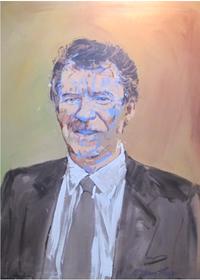
Henry Mee was born in Bishop’s Stortford, Hertfordshire. He is particularly well known for his portraits. He studied at University of Leeds (1975–9) and his teachers included Lawrence Gowing, Tim Clark, Griselda Pollock, Francis Fraschina and Terry Atkinson. Mee considers himself “a figurative painter in the English tradition, working from life and drawing being of paramount importance”. He made a big impression with his exhibition British Eminences: Portraits of our Age, at Sotheby’s London, which opened on 23rd May 1990.

“Most everything I do, I intend to make on a large scale … Size itself has its own impact and physically we can relate ourselves more strongly to a big sculpture. At least I do.” - Henry Moore Cast in 1962, the same year Sir Peter and Lady Michael were married, this piece was bought at Christie’s in November 1986. The previous owners, Mr and Mrs James A. Clark Jr from Dallas, Texas, had purchased the work directly from Henry Moore after visiting his studio.
Katherine Palmers-Needham is an abstract painter interested in colour and the nature of paint. Katherine was born in London in 1970 and later returned there to study for her degree in painting. In 2003 Katherine graduated from Chelsea College of Art with a First-Class Honours degree. Katherine Palmers-Needham loves the excitement of making paint sing and play. Her paintings are created through a process of addition and subtraction. She builds up multiple layers of colour with translucent glazes, mixing her pigments with specialist oil mediums for varying effects.
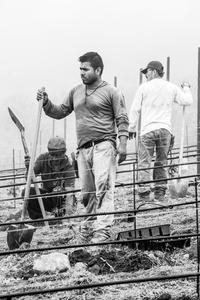
I think HAVING LAND and NOT RUINING IT is the MOST BEAUTIFUL ART that anybody could ever want" - Andy Warhol Donna Reid is a professional photographer who specialises in natural photography, and is based near Lake Tahoe in California, United States. Donna has worked with the Peter Michael Winery as a photographer since 2015 by capturing its day-to-day workings. She was awarded a degree in photojournalism from the University of Florida, and is passionate about creating “compelling” and “remarkable images” of nature using natural light using her digital camera.

I think HAVING LAND and NOT RUINING IT is the MOST BEAUTIFUL ART that anybody could ever want" - Andy Warhol Donna Reid is a professional photographer who specialises in natural photography, and is based near Lake Tahoe in California, United States. Donna has worked with the Peter Michael Winery as a photographer since 2015 by capturing its day-to-day workings. She was awarded a degree in photojournalism from the University of Florida, and is passionate about creating “compelling” and “remarkable images” of nature using natural light using her digital camera.
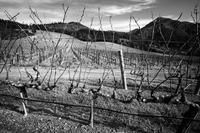
I think HAVING LAND and NOT RUINING IT is the MOST BEAUTIFUL ART that anybody could ever want" - Andy Warhol Donna Reid is a professional photographer who specialises in natural photography, and is based near Lake Tahoe in California, United States. Donna has worked with the Peter Michael Winery as a photographer since 2015 by capturing its day-to-day workings. She was awarded a degree in photojournalism from the University of Florida, and is passionate about creating “compelling” and “remarkable images” of nature using natural light using her digital camera.
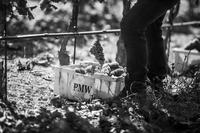
I think HAVING LAND and NOT RUINING IT is the MOST BEAUTIFUL ART that anybody could ever want" - Andy Warhol Donna Reid is a professional photographer who specialises in natural photography, and is based near Lake Tahoe in California, United States. Donna has worked with the Peter Michael Winery as a photographer since 2015 by capturing its day-to-day workings. She was awarded a degree in photojournalism from the University of Florida, and is passionate about creating “compelling” and “remarkable images” of nature using natural light using her digital camera.
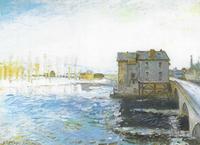
Sisley moved to Moret in 1880 and quickly felt inspired by the town which would remain his home until his death in 1899. He wrote of the place in a letter to the critic Adolphe Tavernier: “It is at Moret – in this thickly wooded countryside with its tall poplars, the waters of the river Loing here, so beautiful, so translucent, so changeable; at Moret my art has undoubtedly developed most… I will never really leave this little place that is so picturesque” (Richard Shone, Sisley, New York, 1992, p.
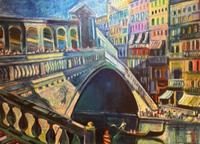
Little is known about Smirnoff’s early life; he was born into a middle-class family in Kharkov in 1894 and he is believed to have had a good education before serving in the Czar’s army during the First World War. Following the 1917 Russian Revolution Boris fled to Japan where he became fascinated with the styles and aesthetics he encountered there. During his time in Japan, he was commissioned to paint some decoration for the Italian Embassy in Tokyo.
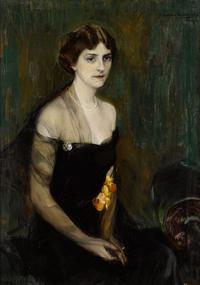
Mrs Orville Babcock was one of a series of portrait commissions undertaken by Sorolla during his stay in Chicago in the early months of 1911. Having first visited New York to present the Hispanic Society of America with some of his new works, Sorolla travelled to Chicago in February, to attend the opening of his major solo exhibition, where the 161 works were viewed by over 100,000 visitors. During this time, Sorolla painted several portrait commissions, four of which, including this work, were included in an exhibition of Portraits at the Art Institute of Chicago the following year.
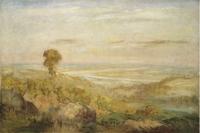
Steer spent the summer of 1909 painting at the house of his friend, J.L. Harrison, whose home overlooked the famous horse-shoe bend of the River Severn at Littledean in Gloucestershire. Steer executed six large canvases of this subject, each painted under different light and weather conditions. Three paintings from the series are now in public collections: Municipal Art Gallery, Dublin; Aberdeen Art Gallery; and Manchester City Art Gallery. Bruce Laughton (loc.
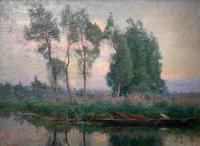
Evening on the Kennet has all the influences and suggestions that originate with the Barbizon school and the later influences of the realist painter Jules Bastien-Lepage. However, rather than being a subject painted on the edges of the forest of Fountainbleu, this is a charming local Berkshire scene along the river Kennet. Adrian Stokes depicts a peaceful atmospheric river landscape with a worker returning with a boat full of vegetation, against either a sunrise or sunset framed by a towering backdrop of trees and reeds.
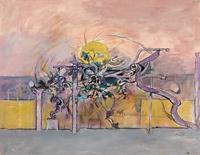
Graham Sutherland made his first trip to the South of France in 1947, a visit which would come to have a profound impact on his both his life and artistic aesthetic. Sutherland returned every summer to the Cote d’Azur where he mingled with glamorous expats such as Somerset Maugham and met both Picasso and Matisse. In 1955 he and his wife Kathleen bought a house in Menton, near the Italian border.

Theo van Rysselberghe (1862-1926) was one of the most important figures in the field of Neo-Impressionism. He introduced the pointillist technique into Belgium and played a major role in the artistic circle of the Brussels avant-garde which in the late nineteenth century was a leading centre of new and exciting international art. The artist made his first steps towards Impressionism from 1880 and in 1883 became one of the six founders of Les XX, a Belgian artistic circle of young radical artists who, like the French Impressionists, rebelled against outmoded academia.
Johannes von Stumm was born in Munich in Germany. He gained his diploma in Fine Art from the Academy in Munich in 1989. He became a fellow of the Royal British Society of Sculptors and was elected President of the society in 2009.
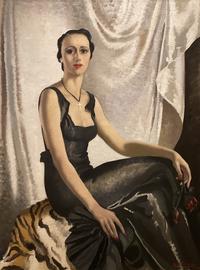
The sitter was born in 1907 in Zuito, Equador, where her father was manager of the Railway and several hotels. Her mother was Spanish and she was educated in England. She became a well-known socialite and was in particular, a great friend of Laurence Olivier and Vivien Leigh. She married three times and died in 1975. Anna Katrina Zinkeisen, was born at Kilcreggan, Dumbartonshire on 29 August 1901, daughter of Victor Zinkeisen (1863-1929), a timber merchant, and his wife Clare née Bolton-Charles.

The present work depicts one of the artist’s favourite subjects, stage and theatre. As the subject suggests, the scene shows three figures in classic pantomime costume. The amusing harlequin wears a mask and a distinctive diamond-patterned outfit and dances around the elegant and beautiful central female figure, whilst a more sinisterly dressed masked musician plays his instrument, allowing the actress to gently dance. Doris Zinkeisen was born at Rosneath, Argyll, Scotland on 31 July 1898, daughter of Victor Zinkeisen (5 July 1863-30 October 1929), a timber merchant and amateur artist, and his wife Clara née Bolton-Charles (7 September 1869-1952), Doris’s younger sister was Anna Zinkeisen.
Doris Zinkeisen was born at Rosneath, Argyll, Scotland on 31 July 1898, daughter of Victor Zinkeisen (5 July 1863-30 October 1929), a timber merchant and amateur artist, and his wife Clara née Bolton-Charles (7 September 1869-1952), Doris’s younger sister was Anna Zinkeisen. In 1909, the family moved to Pinner, near Harrow and she studied at Harrow School of Art and in 1917 won a scholarship to the Royal Academy Schools, where she studied with her sister.

The Woman with the Cigar is a powerful oil painting of Katherine Dunham, a famous American dancer and choreographer. The scene is taken from her dance Caribbean Rhapsody. Dunham had spent two years travelling in the Caribbean studying all aspects of dance, and it was in Haiti that she became particularly inspired by the ethnographic field notes on Vodun rituals that she had made during her time there. Dunham drew on these to inform her Afro-Caribbean inspired dances which, to a predominantly European-dominated dance world, were ground-breaking both to audiences and critics alike.

Having exhibited a painting of Lamia in 1905 (now in the Auckland Art Gallery) and made three additional treatments of the two-figure composition, Waterhouse sent to the Royal Academy’s 1909 Summer Exhibition this one-figure picture bearing the same title. In it the same young woman, arranges her hair alone while studying herself in the water’s reflection. Waterhouse had occasionally shown women with one or both breasts exposed, most notably in Echo and Narcissus (1903, Walker Art Gallery, Liverpool Museums).
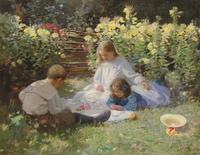
Primarily known for his landscape studies, The Garden Party is at the pinnacle of Watson’s rare ventures into figurative painting. In the late Edwardian summers, nature was seemingly bountiful, and women and children could often be seen enjoying the outdoors. Garden scenes provided Impressionist artists with ideal settings in which to develop their own interpretation of the modern concepts of naturalism and spontaneity, through new techniques using colour and light effects, and a greater sense of dynamism and atmosphere.

‘There is the most beautiful of all his pictures the Dream of Endymion…' Edward Coley Burne-Jones In Greek mythology, Selene (the goddess of the moon who was sometimes regarded as the personification of the moon itself), is known for her affair with the beautiful mortal Endymion, the young shepherd who used to sleep on a mountaintop, and with whom she had fifty daughters. In Roman mythology, Diana has the attributes of Selene and a similar myth tells of her falling in love with Endymion.

G. F. Watts is one of the most remarkable and versatile figures in Victorian art. During his long career of some seventy years, he made major contributions to history painting, the mural revival, portraiture, landscape, high Victorian classicism, symbolism, and the new sculpture. Watts, particularly with his more Symbolist paintings, dared to take risks and he ‘dragged English painting out of the eighteenth century and propelled it into the twentieth.’ (Jefferies.
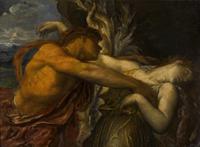
‘And now they were not far from the verge of the upper earth. He, enamoured, fearing lest she should flag and impatient to behold her, turned his eyes; and immediately she sank back again. She, hapless one! both stretching out her arms and struggling to be grasped and to grasp him, caught nothing but the fleeting air. And now, dying a second time, she did not at all complain of her husband; for why should she complain of being beloved?
